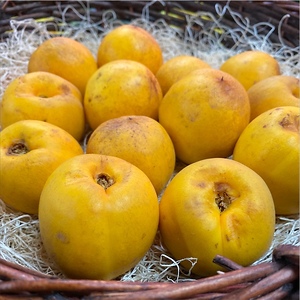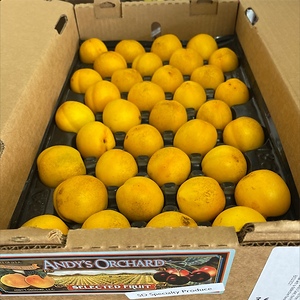


Silk Road Nectarines
Estimated Inventory, lb : 0
Description/Taste
Silk Road nectarines are a smaller variety with a round to oval shape. The skin is smooth, taut, and delicate, easily bruised, and has a unique, vibrant gold hue without the characteristic red blushing commonly associated with other nectarine varieties. Underneath the surface, the flesh is bright yellow, semi-soft, aqueous, and dense, encasing a large, dark brown pit that can be easily removed. Silk Road nectarines emit a honeyed fragrance and have a distinct flavor that is initially sweet, balanced by an acidic, tangy bite with subtle nuances of apricots.
Seasons/Availability
Silk Road nectarines are available in the late summer.
Current Facts
Silk Road nectarines, botanically classified as Prunus persica, are rare, golden fruits belonging to the Rosaceae family. The sweet-tart fruits are descendants of yellow nectarine varieties sourced from Tashkent, Uzbekistan, a prominent city situated along the famous silk road trade route. Multiple varieties of Uzbek nectarines were brought to the United States in the late 20th century, and once established, they were eventually crossed with California nectarines to create improved cultivars, including Silk Road nectarines, for local cultivation. Silk Road nectarines are not sold commercially and are only grown through select specialty farms. The variety is also grown in some home gardens, but it can be challenging to cultivate due to fruit flies, brown rot, and the fruit’s delicate nature. Despite their rarity, Silk Road nectarines are highly favored and desired among chefs for their distinct flavor, golden skin, and yellow flesh.
Nutritional Value
Silk Road nectarines are a good source of vitamin C, an antioxidant that can strengthen the immune system, reduce inflammation, and boost collagen production within the skin. The fruits also contain potassium to help regulate blood pressure and fluid levels and provide some beta-carotene, a nutrient that gets converted into vitamin A in the body to protect against aging of the eyes and skin.
Applications
Silk Road nectarines are best suited for raw and cooked applications, including baking, grilling, and simmering. The rare variety is primarily eaten straight, out-of-hand, as the fruit is highly valued for its golden flesh and raw applications showcase this distinct trait. Silk Road nectarines can be sliced and tossed into green salads, mixed into fruit bowls, thinly cut and used as a fresh topping over desserts and yogurt, or sliced and utilized as an edible garnish. The yellow fruits can also be chopped into salsas, blended into sauces, cooked into jams and jellies, or grilled for a savory, sweet-tart flavor. In addition to savory applications, Silk Road nectarines can be incorporated into cobblers, pies, ice cream, and other baked goods as the fruits have a firmer consistency, which allows them to hold their shape when baked. Silk Road nectarines can also be dried for extended use and eaten as a snack, mixed into baked goods, or used to sweeten soups, stir-fries, and roasted meats. Silk Road nectarines pair well with vanilla, cinnamon, ginger, herbs such as basil, mint, cardamom, and rosemary, other fruits including raspberries, figs, blueberries, mangoes, and blackberries, and nuts such as almonds, hazelnuts, and macadamia. Whole Silk Road nectarines that are still firm can be left to ripen at room temperature for 1 to 3 days. Once softened, the fruits should be stored in the refrigerator for up to one week.
Ethnic/Cultural Info
The California Rare Fruit Growers, or CRFG, is an amateur fruit-growing organization established in 1968 to develop rare fruit varieties, including Silk Road nectarines, that are not native to California. Within the CRFG organization, local chapters are focusing on a specific region and climate, and each chapter publishes a list of events that they are hosting throughout California to encourage the cultivation of rare and unusual fruits. One of the organization’s most famous events is the annual scion exchange. Scion wood is a twig or shoot from a particular variety that is collected for grafting. During the scion exchange, breeders and home gardeners can trade scion wood to diversify and expand their fruit collections. Silk Road nectarines are primarily exchanged through the CRFG Santa Clara chapter, and during the exchange, grafting experts also give demonstrations to help educate growers on perfecting a successful graft. In addition to the scion exchanges, CRFG hosts a Festival of Fruit, which is an annual celebration of growing rare fruit in the Western United States. The Festival of Fruit has been occurring for over fifty years and features educational cultivation talks, plant vendors, networking events, and live demonstrations.
Geography/History
Silk Road nectarines are related to gold-skinned nectarines sourced by Andy Mariani in the early 1990s from Tashkent, Uzbekistan. Central Asia is believed to be the center of origin for nectarines, and the area was mostly kept hidden from the rest of the world from the 1800s until the collapse of the Soviet Union in 1991. Once the ban on traveling to Central Asia to collect seeds was lifted, Andy Mariani of Andy’s Orchard in Morgan Hill, California, traveled to Uzbekistan and sourced many rare yellow nectarines for cultivation in the United States. The California Rare Fruit Grower’s Santa Clara Valley chapter took one variety of the Uzbek nectarines, known as the tashkent nectarine, and crossed it with a California nectarine to create the Silk Road nectarine. Today, Silk Road nectarines are mainly grown through Andy’s Orchard in Morgan Hill, California, a specialty farm growing over one hundred stone fruit varieties. The fruits are also grown on a smaller scale through select home gardeners.
Recipe Ideas
Recipes that include Silk Road Nectarines. One









